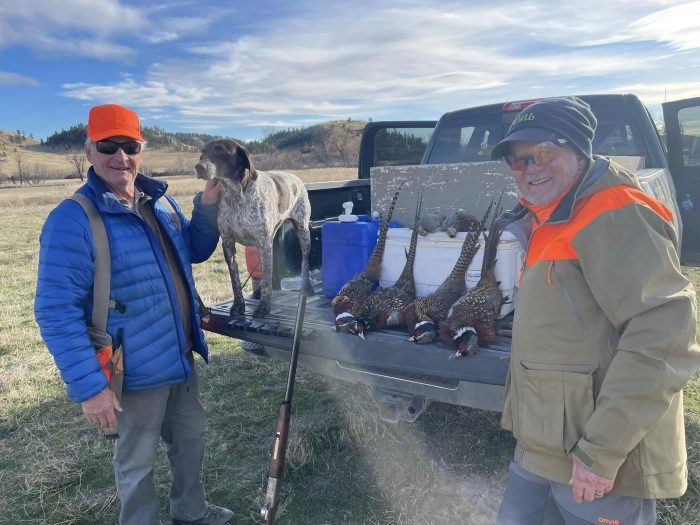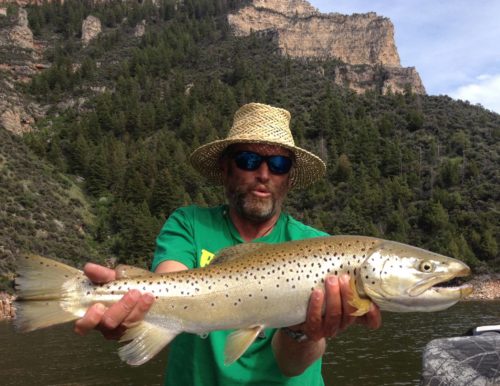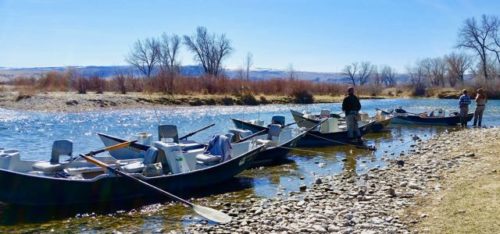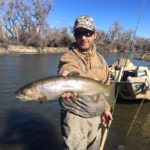Tom & Greg Upland Hunting 2022

Don’t Fear The Worm!

Probably ought to start refilling that Steel Worm bin…
No, we are not talking about tequila (does anybody really do that?), but we are talking about that fly tied to the end of your leader. That’s right, the both mighty and humble worm. There are a bunch of various patterns that imitate this food organism to trout, from the original chenille San Juan, to the modern soft and chewy Squirmy Worm, to one of the Bighorn favorites, the Steel Worm. From the enthusiastic “Heck yeah, I love a good worm bite!”, to the “I am NOT, fishing a worm”, few flies are capable of evoking such strong opinions and reactions out of fly anglers.
Seasoned fishing guides and anglers generally fall into the enthusiastic camp when it comes to worms, and for good reason. Almost without fail, when these organisms are abundant and available to the trout, the fishing is typically very good. To better understand why this is, it helps to know a little bit about the humble worm. The first thing to understand is that the worms we are talking about are aquatic worms. That’s right, they live in the river. Rivers that are most abundant with aquatic worms generally have a low gradient (i.e. slower currents), are somewhat silty, and are nutritionally rich. Most Western tailwater rivers (rivers that are fed by a dam and large reservoir) meet this description. A few examples would include the North Platte in Wyoming, San Juan in New Mexico, and the Missouri, Beaverhead, and Bighorn in Montana. All of these rivers have the right combination of factors that make them aquatic worms factories, which significantly contribute to these river’s biomass and are one of the important reasons that they tend to produce healthy populations of decent sized trout.
Aquatic worms usually become abundant and available to trout during periods of higher river flows. As mountain runoff begins to melt and fill the reservoirs behind the dams, more water is released into the river in order to make room. These periods of higher flow in the spring tend to wash out accumulated silt, which is where aquatic worms generally live. As the silt is displaced into the current, so are the worms. Imagine a typical Bighorn River brown trout. You’re making a living throughout the year by eating a lot of really small bites; sowbug, scuds, midges, some caddis and mayflies, and an occasional minnow, snail or leech. In the fall you go through the annual spawning ritual and loose body mass as you devote a lot of energy into cutting redds (for females), chasing off competitive suiters (for males), and then laying and fertilizing eggs. As the spawn winds down it’s into December, and then come the lean months of winter, where you feed on sparse hatches of tiny midges, mayflies and the odd scud and sow bug in the drift. By spring you are ready to eat and put that body mass back on. As the days get longer, the water warms, the river rises, and suddenly there are hundreds of thousands of meaty aquatic worms drifting in the feeding lanes. Life is good! You take advantage of this opportunity and voraciously feed on these organisms, sometimes ignoring other food forms in order to efficiently put as many calories as possible in your body in the time given. In the span of a couple of weeks, you go from being pale, silvery, and skinny to a plump golden brown that the Bighorn is famous for.
The keen angler (and guide) takes advantage of this type of feeding behavior by the trout. It’s no different from taking advantage of the same behavior when hatching insects are abundantly available such as mayflies, caddis, stoneflies, and midges. Although the worm bite isn’t a “hatch” in the traditional sense, by fishing a worm pattern during these times, you are essentially “matching the hatch” by selecting a fly pattern that represents the food form most available to the trout. I know a guide who was flat out accused of not understanding aquatic entomology because he tied on a worm pattern for a client. That situation was rare and unfortunate, and only served to illustrate the ignorance of his client. However, it’s a lot less rare to meet an angler who doesn’t make insulting accusations, but turns their nose up at a worm pattern. Yes, it may not be as idilic as stalking a pod of rising trout sipping size 22 trico spinners from the surface with a perfectly tied flat wing spinner, but it is the same concept none-the-less.
So the next time you hop into a drift boat, and your guide ties on that simple little red, or purple, or brown, or wine chenille worm fly, don’t fear the worm! It’s not an insult or reflection on your angling ability, it is simply a matter of working with what the river happens to be dealing at that particular time. And if you really can’t get past it, look at booking your trip when those pods of trout are sipping sized 22 trico spinners, just make sure you’ve practiced hitting a dinner plate at 40 feet, but that’s another post for later!
Cheers!
From the Guide Shack…
Tyler
Guide Spotlight: Dell Despain

A native of Utah, Dell started fly fishing as a kid on trips to the mountains with his Dad. Those early experiences lit a fire for the sport that still burns bright 5 decades later. In 1998 Dell sold his successful bakery business in Utah and found his way to Montana and began guiding on the Bighorn that same year, giving Dell 20 years and thousands of days on this blue ribbon trout fishery.
During Dell’s guiding career he has worked nearly every major river in the state, from the freestone streams on the western edge of Montana, to the spring creeks of Paradise Valley. In 2006 alone he guided on 12 different rivers around Montana! These days he has narrowed his focus to the Bighorn. Having fished and guided a wide range of places, Dell feels that without a doubt, the Bighorn is one of the best. He is also known as an innovative fly tier and is a Signature Fly Designer for Yellowstone Fly Goods, a Billings, Montana based wholesale fly production company.
Known among fellow guides for his passion and love for both fly fishing and fine cigars; he’s also somewhat famous in the Valley as a good natured practical joker. Among clients he’s known for his seasoned professionalism, focused work ethic and willingness to tailor the day to meet his anglers needs and expectations. Whether you are a novice, an expert dry fly technician, or somewhere in between, Dell draws from a deep well of experience and can show you the best of what the Bighorn has to offer.
Dell lives in Billings with his wife and three children Scout, Emma, and Magnus; and his loyal Jack Russel, Bob.
Q & A Rapid Fire:
If you only had ONE fly to fish the Bighorn: Pink Soft Hackle Sowbug
Favorite Month to Fish the Bighorn: June
Favorite Cigar: CAO Brazilia
What are you doing if you’re not fishing: Mountain Biking
Welcome To The Boat Lean

Around most fly fishing lodges and shops it’s not uncommon to find guides hanging around at the end of a long hot day rehashing events; flies that worked, runs that fished well, jokes, whatever, are the usual conversation. These informal debriefs usually take place around a drift boat, which serves to prop up said guides, and makes a convenient drink holder for the customary cold beers that are enjoyed. Go to any trout river in the West, and at days end you’re likely to spot one. And if you really want to know the low down, this is the place to get the goods. It’s known among trout guides as “The Boat Lean”.
We’ve actually had a blog on our website for quite a few years now. This season we are planning to add more content to keep you better connected to what’s happening here on the Bighorn and at Eagle Nest. We will be inviting some of the guides to help out in order to bring new content and for their perspective on what’s happening- including more timely and up to date fishing reports.
In addition to fishing and hunting reports we would like to add some gear reviews, fishing and hunting photos and even some short articles for your reading enjoyment. So give us a bookmark on the link above, grab a favorite warm or cold beverage, and welcome to The Boat Lean.
Thank you and we hope you enjoy!
Guide Spotlight: Sam Boggio
At Eagle Nest we understand the importance of having quality guides to spend your day with on the river. After all, you spend a large portion of your time here with them, and a good guide, regardless of how the fishing happens to be, can make or break your overall experience. Fortunately for us, the majority of our guides have been with us for many seasons. Although many of our guest who return season after season have developed friendships with these guys, we want to take some time to introduce them on an individual basis so you can get to know them a little better.
Guide Spotlight: Sam Boggio
Few guides in the entire Bighorn Valley can claim to have fished the Bighorn longer than Sam Boggio. Born and raised in Hardin, Montana Sam has been fishing the Bighorn for nearly 4 decades. As a kid Sam recalls that day when his uncle asked him if he wanted his old fly rod to try using on the river. Sam took him up on that offer, and despite what he describes as a rough beginning, he stuck with it, achieving a skill level that today few will ever attain. When Sam was 14 years old he started tying flies commercially for the now closed Quill Gordon Fly Fishers, one of the rivers very first fly shops to open. At 19 years old Sam did his first guide trip on the Bighorn for Eagle Nest Lodge, and as trite as it may sound, he never looked back. The 2018 season will mark Sam’s 20th season as a full time professional guide on the Bighorn River. We would estimate that 20 years represents well over 2500 guide days, not to mention all the personal fishing days in there as well. In a profession where experience counts, few can draw on that kind of knowledge. In addition to being a fishing guide, Sam has also worked 10 seasons as a big game guide for elk and deer.
“Steady as she goes” is an old seafaring term, and would be a pretty apt description of Sam’s style. Sam is also know for his sharp wit among fellow guides, who despite repeated attempts, are usually stymied when trying to give him a good burn from time to time. Good natured and quick with a joke, if you ever want to get Sam really talking, just bring up elk hunting. But don’t be fooled, Sam’s first love is still fly fishing, and that pursuit has taken him from the trout filled blue ribbon rivers around Montana and Wyoming to the saltwater flats of the Yucatan Peninsula.
Sam lives in Billings, MT with his wife and two young children Edison and Emmi.
Q & A Rapid Fire:
If you only had ONE fly to fish the Bighorn: White Zonker Streamer
Favorite Month to Fish the Bighorn: July
Favorite Beer: Ice Cold and Yellow
What are you doing if you’re not fishing: Probably elk hunting or thinking about elk hunting.
